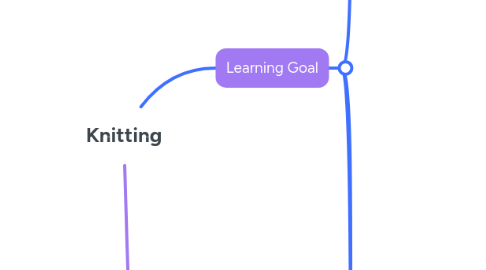
1. Learning Goal
1.1. Learning Stratergies
1.1.1. Primary Sources
1.1.1.1. Family Members
1.1.1.2. Experts on Knitting
1.1.1.2.1. To give feedback and advise to better my techniques and give suggestions
1.1.1.3. AIF Teacher
1.1.2. Library Recourses
1.1.2.1. Library Staff
1.1.2.1.1. To give suggestions on where to find information related to knitting such as the history of knitting and research into techniques.
1.1.2.2. Library Books
1.1.2.2.1. Gives a more detailed response to general information known about knitting and is a central place for lots of information.
1.1.3. YouTube
1.1.3.1. Tutorials for different basic stitches
1.1.3.2. Tutorial for final learning output.
1.1.3.3. Tutorial on how to read knitting patterns
1.1.3.3.1. Gives in depth tutorial for specific actions and provides visual aids for visual learners
1.1.3.4. Tutorials for beginner knitters and what to know
1.1.3.5. Tutorials on how to use different materials
1.1.4. Social Media Recources
1.1.4.1. TikTok Videos
1.1.4.1.1. Often provides a realistic timeline for projects and provides feedback on their process.
1.1.4.1.2. There is a wide range of peoples perspectives on social media platforms therefor it is easy to find someone at your similar skill level to check your work against theirs.
1.1.4.2. Instagram Reel / Post
1.1.5. Website/Blog Posts
1.1.5.1. Knitting Community Blogs
1.1.5.2. Material Reviews
1.1.5.2.1. Gives real life feedback and perspectives on specific processes and provides improvements or alternative better ways to produce the product.
1.1.5.3. Website reviews
1.1.6. Knitting Books
1.1.6.1. Spotlight Knitting tutorial books
1.1.6.1.1. Provides detailed written patterns and tips along with pictures to aid visual learners
1.1.6.2. Knitting Magazines
1.2. What will I need to learn to be succesful?
1.2.1. The Continental Technique
1.2.1.1. As per my research, the continental technique is more closely related to the crochet technique. As I already know how to crochet, the continental technique would progress my learning futher and quicker than if I used the English Technique due to my familiarity.
1.2.2. Knitting Terminology and Reading Patterns
1.2.2.1. Learning how to fluently read written patterns and understand different terminologys for the same action can quicker progress my learning and my production of learning output as I wouldnt have to look up each stitch and technique.
1.2.3. Basic Stitches
1.2.3.1. By creating a strong base knowledge of knitting and the frequently used stitches it can allow me to progress into harder stitches of projects which often have stitches which are just the advanced level of the basic stitch.
1.2.4. Communication and Connectivity (Seeking Perspectives)
1.2.4.1. These skills will allow me to utilize my sources in the most efficient way by asking the right and most relevant questions regarding feed back or general information on the topic.
1.2.5. Time Management Skills
1.2.5.1. Learning how to manage my time efficiently and will be a good future life skill sue to my busy schooling and sporting schedule and will also improve my ability to finish my final portfolio, progress checks and final learning output.
1.2.6. Flexability in Plans / Percerverance
1.2.6.1. As this is a big project to tackle in just over a term, there will be times where is may not be able to add in everything from my original plan and i also may not get the final result. Being able to adapt my initial plan will be crucial for setting realistic choices and making dicerning judgements.
1.2.7. Sustainability
1.2.7.1. Different materials may be more sustainable for the environment.
1.2.7.2. The reusage of different clothings to create yarn, reduce, reuse, recycle initiative.
1.2.7.3. Undoing previous practice attempts to save and reuse yarn.
1.2.7.4. Asking people I know that knit if they had any practice materials i could try out before investing in my own materials.
1.2.8. Best Materials for Knitting Styles
1.2.8.1. By investigating the best knitting needles, yarn, patterns and stitch markers for my specific project I can increase the likelyhood of my final learning output being successful the first time around and allowing my vison to come to life.
1.3. How will I apply what I have learnt?
1.3.1. By using these skills I will be able to have a basic understanding of knitting from my base of no knowledge and will have the skills to read patterns and create items from scratch such as my final learning output.
